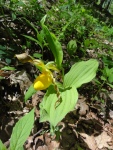It’s a beautiful spring day, the kind with just enough crisp in the breeze to start out with a light jacket, just enough sun in the sky to later slip it off. The Appalachian mountains call me this time of year. On the forest floor lady-slippers and trillium bloom yellow and pink, while high above, tall trees re-sheathe their limbs in green. Fat robins rustle in the nearby brush. Sun-dappled shade filters through the canopy, lighting a flame azalea on a far hillside, making it look for all the world like the mystical, ethereal burning bush.
I grew up going camping with my family and Girl Scout troop, and more and more in recent years I’ve sought again the solace of the trees. Or maybe I’m seeking more smarts—science tells us that time spent in nature both reduces stress levels and improves cognitive function. Elizabeth Kwak-Heffernan, in a May 2012 article in Backpacker magazine, cites a University of Rochester study (2010) that showed even 15 minute nature walks gave rise to a greater sense of “vitality”; she also describes an environmental neuroscience project that shows how “exposure to nature causes significant, measurable changes to the brain” that “let you think more clearly, focus more acutely, and perform to your maximum cognitive ability.”
But it doesn’t really take a research study to convince me time spent in the woods is good for the soul.
Walking on a trail encourages me to slow down but keep moving. That’s in direct contradiction to what so much of the world—with its trains and planes and lightning-speed internet access—usually demands: go and do faster, but keep your butt parked in a chair. The latter is a recipe for both stagnation and disorientation. Wendell Berry notes in “An Entrance to the Woods,” “we seem to grant to our high–speed roads and our airlines the rather thoughtless assumption that people can change places as rapidly as their bodies can be transported” but “[o]ur senses…were developed to function at foot speeds.” We’re meant to walk, to keep moving forward with our bodies and our minds; we’re also meant to slow down and savor. When we do, we really see and appreciate what’s around us.
That’s something else the woods remind me to do: be present and pay attention. There’s the practical piece of paying attention to warning signs (leaves of three, a mysterious rattle) and walking the other way. On the other hand, it’s important to remember that what is good and beautiful rarely announces itself with a big flourish. Most days a neon-orange Eastern newt is more likely to cross your path than a mama bear and her cub. You have to remain receptive, look closely. Jack- in-the-Pulpit hides its bullet-shaped spadix and striped spathe under a tall umbrella of broad leaves. The more beauty you look for, the more you see. Paying attention to small wonders has a cumulative effect.
Time spent in the woods also makes me mindful of the “leave no trace” doctrine, and how my actions affect others. We can’t help but impact the elements of the world we encounter, but we can choose to minimize negative effects, take responsibility for our own stuff, and strive always to leave things better than we found them.
♥ ♥ ♥
Slow down but keep moving forward. Pay attention and appreciate the small gifts. Leave things better than you found them. Not a bad formula for loving and respecting the planet. Not a bad formula for loving and respecting your partner, either.




